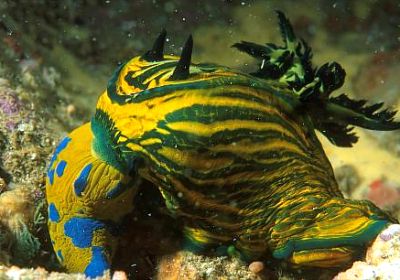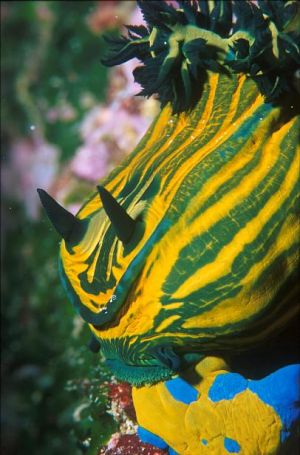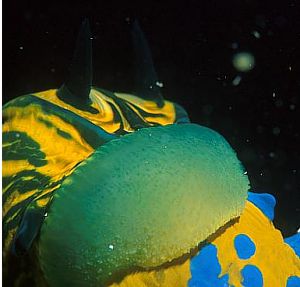Roboastra luteolineata vs Tambja verconis
October 25, 2001
From: Ross and Diane Armstrong

Dear Bill,
Thought you might enjoy these photos taken at the Poor Knights on Sunday. Diane made the discovery of Roboastra luteolineata with its mouth full of a Tambja verconis. The visibility was only about 5m so it did not make for the best photographic opportunities. We found it with less than half the T. verconis remaining and watched it slowly eat it down to less than a third remaining before we ran out of film. We went back to our boat and changed film but when we returned 45 minutes later it had finished its meal and looked full to bursting. What we found particularly interesting was how it extended its mouth to feed.
Kind regards
Ross and Diane Armstrong
ross@oceanwildlife.com


Dear Ross & Diane,
What a wonderful find - though a bit sad for the Tambja. It is certainly convincing support for my view that the striped animal is a species of the nudibranch-hunting genus Roboastra rather than the bryozoan-feeding genus Tambja. Actually in your upper photo we can see the whole food chain, for at the bottom left I can see some small branches of the bluish arborescent bryozoan Bugula dentata on which Tambja verconis feeds.
Although we call the mollusc radula their 'teeth' they work in quite a different way to vertebrate teeth. A carnivorous vertebrate like a dog or a lion woud use its teeth to bite off or tear off chunks of flesh and swallow them. The mollusc radula can perhaps be compared with having teeth on our tongue. Although they can be manipulated in ingenious ways, molluscs have never evolved a way to use the radula to bite of large chunks. In carnivorous hunters the teeth have become a set of grappling hooks which can grab and hold on to their prey while the the 'oral tube' which is a very extensible region just inside the mouth, extends out of the mouth by turning inside out, and wraps itself around the prey. Once it has done this it can then pull itself and the prey back into its body for digestion.
I think this is the first record of anyhting feeding on Tambja verconis and I don't know of any observations of Roboastra luteolineata feeding in Australia or NZ. Atsushi Ono has a couple of photos of it in his book feeding on another species of Tambja in Japan.
Thanks again for sharing this very interesting observation.
Best wishes,
Bill Rudman
Related messages
-
Roboastra luteolineata laying eggs
From: Deb Aston, May 6, 2010 -
Re: Roboastra luteolineata - Feeding behaviour!
From: Graham Abbott, August 4, 2007 -
Re: Roboastra luteolineata - Feeding behaviour!
From: Graham Abbott, July 24, 2007 -
Roboastra luteolineata - Feeding behaviour!
From: Graham Abbott, January 23, 2007 -
Roboastra luteolineata eating Nembrotha kubaryana
From: K. Anderson, February 7, 2006 -
Roboastra luteolineolata from Great Barrier Reef
From: Pasquale Pascullo, December 19, 2005 -
Re: Feeding habits of Roboastra
From: Bieke Daneels, July 10, 2004 -
Roboastra luteolineata from Kapalai
From: Maliza, June 4, 2003 -
More on Roboastra feeding
From: Ross & Diane Armstrong, October 26, 2001 -
Roboastra luteolineata from the Solomons
From: Scott Johnson, September 30, 2001 -
Roboastra cf. luteolineata from Sth Africa
From: Valda Fraser, July 3, 2001 -
Re: T. affinis v. R. luteolineata
From: Ross and Diane Armstrong, April 24, 1999 -
Tambja affinis v. Roboastra luteolineata
From: Ross Armstrong, April 23, 1999 -
Re: Roboastra luteolineata
From: Ross Armstrong, February 24, 1999 -
Robastra luteolineata - new for New Zealand
From: Ross Armstrong, February 22, 1999
